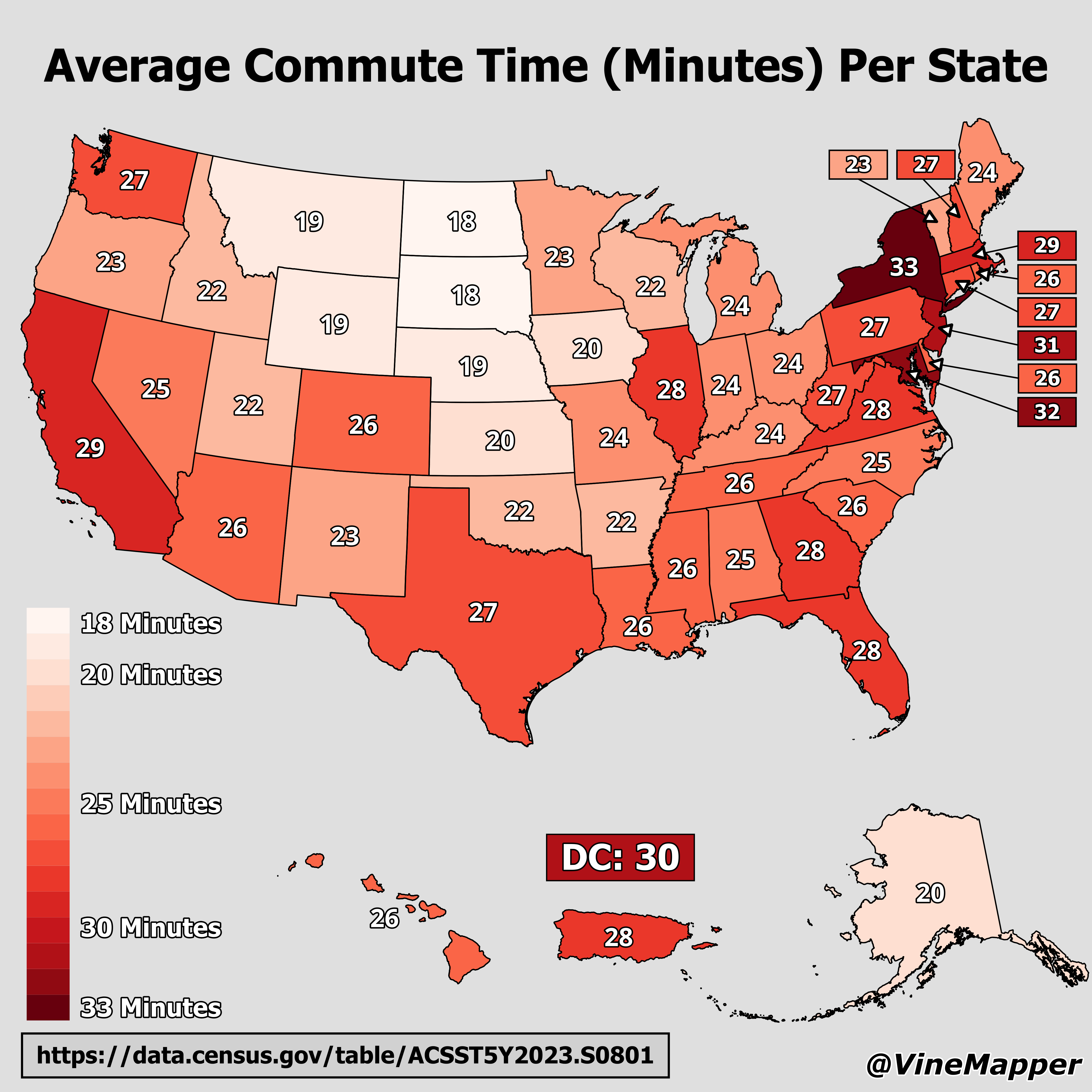Average Commute Time Map by State


Alex Cartwright
Senior Cartographer & GIS Specialist
Alex Cartwright is a renowned cartographer and geographic information systems specialist with over 15 years of experience in spatial analysis and data...
Geographic Analysis
What This Map Shows\nThis map illustrates the average commute time in minutes for each U.S. state, offering a clear visual representation of how long residents typically spend traveling to and from work. Commute times can vary greatly depending on a variety of factors such as population density, urban versus rural living, and the availability of public transportation. Understanding these patterns can provide insights into broader geographic and economic trends across the country.
Deep Dive into Commute Times\nCommute times are not just numbers; they reflect the daily experiences of millions of Americans. According to the U.S. Census Bureau, the national average commute time is approximately 26 minutes. However, there are significant variations across states due to geographic, social, and economic factors.
For instance, states with larger urban populations, such as California and New York, tend to have longer average commute times due to heavy traffic congestion and the reliance on road networks to accommodate a significant number of commuters. In contrast, states with lower population densities, like Vermont and Wyoming, often enjoy shorter commute times because of less traffic and a more dispersed population.
Interestingly, the nature of commute also varies. In states where public transportation is robust, such as New York and Illinois, residents may spend considerable time in transit, yet they may not be behind the wheel. In these states, public transit options can actually reduce stress and improve the commuting experience, despite longer overall travel times. Conversely, in states like Texas, where car ownership is nearly universal, longer commute times can be attributed to road congestion.
Moreover, economic factors play a crucial role in commute patterns. States with a high concentration of jobs in urban centers naturally attract workers from suburban and rural areas, leading to longer travel times. The economic dynamics in these regions often lead to an increase in housing prices as demand for homes closer to urban job centers rises, pushing many to live further away and increasing their commute times.
Regional Analysis\nWhen analyzing the map, regional differences become apparent. For example, states in the Northeast, such as New Jersey and Maryland, show some of the highest average commute times, often exceeding 30 minutes. This can be attributed to the dense population and the complex transportation infrastructure that many residents navigate daily. Interestingly, New Jersey has frequently been noted for having one of the longest average commutes in the nation, reflecting its proximity to major urban areas like New York City.
In contrast, states in the Midwest, like Indiana and Iowa, tend to have shorter commute times, often averaging around 20-24 minutes. This difference can be linked to lower population density and a greater prevalence of single-family homes, which allows for shorter travel distances to workplaces.
Southern states, including Florida and Georgia, present a mixed picture. Urban areas like Atlanta have notoriously long commutes due to traffic congestion, while more rural areas in these states enjoy much quicker travel times. This disparity highlights the importance of urban planning and infrastructure in shaping commuting experiences.
On the West Coast, California showcases an extreme case, with cities like Los Angeles and San Francisco reporting some of the longest commute times in the country. The sheer volume of traffic combined with geographic barriers like mountains and coastlines exacerbates the situation, making commute times a significant concern for residents.
Significance and Impact\nThe implications of average commute times extend beyond just inconvenience; they have profound effects on quality of life, economic productivity, and environmental sustainability. Longer commute times can lead to increased stress levels, reduced time for family and leisure activities, and greater fuel consumption, which contributes to environmental degradation.
Moreover, as remote work becomes more prevalent, shifts in commuting patterns are likely to continue evolving. Some experts predict that as more companies adopt hybrid work models, average commute times may decrease in the long run. However, this also raises questions about urban planning and whether cities can adapt to these changes effectively.
Ultimately, understanding average commute times by state is crucial for policymakers, urban planners, and residents alike. It highlights the need for improved public transportation options, better infrastructure, and policies that support sustainable commuting practices. As we look toward the future, addressing these challenges will be essential in creating livable, efficient, and environmentally friendly communities across the United States.
Visualization Details
- Published
- September 8, 2025
- Views
- 104
Comments
Loading comments...